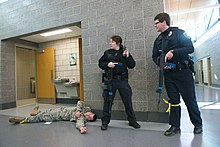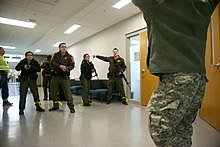The Occupational Safety and Health Administration is a regulatory agency of the United States Department of Labor that originally had federal visitorial powers to inspect and examine workplaces. The United States Congress established the agency under the Occupational Safety and Health Act, which President Richard M. Nixon signed into law on December 29, 1970. OSHA's mission is to "assure safe and healthy working conditions for working men and women by setting and enforcing standards and by providing training, outreach, education, and assistance." The agency is also charged with enforcing a variety of whistleblower statutes and regulations. OSHA's workplace safety inspections have been shown to reduce injury rates and injury costs without adverse effects on employment, sales, credit ratings, or firm survival.

The Occupational Safety and Health Act of 1970 is a US labor law governing the federal law of occupational health and safety in the private sector and federal government in the United States. It was enacted by Congress in 1970 and was signed by President Richard Nixon on December 29, 1970. Its main goal is to ensure that employers provide employees with an environment free from recognized hazards, such as exposure to toxic chemicals, excessive noise levels, mechanical dangers, heat or cold stress, or unsanitary conditions. The Act created the Occupational Safety and Health Administration (OSHA) and the National Institute for Occupational Safety and Health (NIOSH).
The permissible exposure limit is a legal limit in the United States for exposure of an employee to a chemical substance or physical agent such as high level noise. Permissible exposure limits were established by the Occupational Safety and Health Administration (OSHA). Most of OSHA's PELs were issued shortly after adoption of the Occupational Safety and Health (OSH) Act in 1970.

The Federal Protective Service (FPS) is a federal law enforcement agency of the United States Department of Homeland Security (DHS). It is also "the federal agency charged with protecting and delivering integrated law enforcement and security services to facilities owned or leased by the General Services Administration (GSA)"—over 9,000 buildings—and their occupants.

The Federal Law Enforcement Training Centers serves as an interagency law enforcement training body for 105 United States government federal law enforcement agencies. The stated mission of FLETC is to "...train those who protect our homeland". Through the Rural Policing Institute (RPI) and the Office of State and Local Training, it provides tuition-free and low-cost training to state, local, campus and tribal law enforcement agencies.
Hazardous Waste Operations and Emergency Response is a set of guidelines produced and maintained by the Occupational Safety and Health Administration which regulates hazardous waste operations and emergency services in the United States and its territories. With these guidelines, the U.S. government regulates hazardous wastes and dangerous goods from inception to disposal.
The Michigan Occupational Safety and Health Administration (MIOSHA) is a state government agency that regulates workplace safety and health in the U.S. state of Michigan. Michigan OSHA is an agency within the Michigan Department of Licensing and Regulatory Affairs, and operates under a formal state-plan agreement with the Occupational Safety and Health Administration (OSHA).

Workplace violence, violence in the workplace, or occupational violence refers to violence, usually in the form of physical abuse or threat, that creates a risk to the health and safety of an employee or multiple employees. The National Institute for Occupational Safety and Health defines worker on worker, personal relationship, customer/client, and criminal intent all as categories of violence in the workplace. These four categories are further broken down into three levels: Level one displays early warning signs of violence, Level two is slightly more violent, and level three is significantly violent. Many workplaces have initiated programs and protocols to protect their workers as the Occupational Health Act of 1970 states that employers must provide an environment in which employees are free of harm or harmful conditions.

Active shooter is a term used to describe the perpetrator of an ongoing mass shooting. The term is primarily used to characterize shooters who are targeting victims indiscriminately and at a large scale, who oftentimes, will either commit suicide or intend to be killed by police. More generally, an active perpetrator of a mass murder may be referred to as an active killer.

An occupational hazard is a hazard experienced in the workplace. This encompasses many types of hazards, including chemical hazards, biological hazards (biohazards), psychosocial hazards, and physical hazards. In the United States, the National Institute for Occupational Safety and Health (NIOSH) conduct workplace investigations and research addressing workplace health and safety hazards resulting in guidelines. The Occupational Safety and Health Administration (OSHA) establishes enforceable standards to prevent workplace injuries and illnesses. In the EU, a similar role is taken by EU-OSHA.
Compliance training refers to the process of educating employees on laws, regulations and company policies that apply to their day-to-day job responsibilities. An organization that engages in compliance training typically hopes to accomplish several goals: (1) avoiding and detecting violations by employees that could lead to legal liability for the organization; (2) creating a more hospitable and respectful workplace; (3) laying the groundwork for a partial or complete defense in the event that employee wrongdoing occurs despite the organization's training efforts; and (4) adding business value and a competitive advantage.
Right to know is a human right enshrined in law in several countries. UNESCO defines it as the right for people to "participate in an informed way in decisions that affect them, while also holding governments and others accountable". It pursues universal access to information as essential foundation of inclusive knowledge societies. It is often defined in the context of the right for people to know about their potential exposure to environmental conditions or substances that may cause illness or injury, but it can also refer more generally to freedom of information or informed consent.
An incident response team (IRT) or emergency response team (ERT) is a group of people who prepare for and respond to an emergency, such as a natural disaster or an interruption of business operations. Incident response teams are common in public service organizations as well as in other organizations, either military or specialty. This team is generally composed of specific members designated before an incident occurs, although under certain circumstances the team may be an ad hoc group of willing volunteers.

The Health Hazard Evaluation (HHE) program is a workplace health program administered by the National Institute for Occupational Safety and Health (NIOSH). NIOSH developed the HHE program to comply with a mandate in the Occupational Safety and Health Act of 1970 to investigate workplace health hazards reported by employers and employees. According to Section 20(a)(6) of the Act, the Secretary of Health and Human Services is authorized "following a written request by any employer or authorized representative of employees, to determine whether any substance normally found in the place of employment has potentially toxic effects in such concentrations as used or found."
The Oregon Occupational Safety and Health Division is a state government agency that regulates workplace safety and health in the U.S. state of Oregon. Oregon OSHA is a division of the Oregon Department of Consumer and Business Services and operates under a formal state-plan agreement with Occupational Safety and Health Administration (OSHA). Oregon OSHA's regulatory authority comes from the Oregon Safe Employment Act (OSEA); its jurisdiction covers most public and private sector workplaces in the state. Oregon OSHA's expressed mission is "to advance and improve workplace safety and health for all workers in Oregon."
An occupational fatality is a death that occurs while a person is at work or performing work related tasks. Occupational fatalities are also commonly called "occupational deaths" or "work-related deaths/fatalities" and can occur in any industry or occupation.

A physical hazard is an agent, factor or circumstance that can cause harm with contact. They can be classified as type of occupational hazard or environmental hazard. Physical hazards include ergonomic hazards, radiation, heat and cold stress, vibration hazards, and noise hazards. Engineering controls are often used to mitigate physical hazards.
Operations Plus WMD is a training level in dealing with hazardous materials.

The Uvalde school shooting was a mass shooting that occurred on May 24, 2022, at Robb Elementary School in Uvalde, Texas, United States, when 18-year-old Salvador Ramos, a former student at the school, fatally shot 19 students and two teachers, while 17 others were injured but survived. After shooting and severely wounding his grandmother at their home earlier that day, Ramos drove to and entered the school, remaining in an adjoining classroom for more than an hour before members of the United States Border Patrol Tactical Unit fatally shot him after they bypassed numerous local and state officers who had been in the school's hallways for over an hour.

Investigative Assistance for Violent Crimes Act of 2012 (IAVCA) is a federal law in the United States that clarifies the statutory authority for federal law enforcement agencies to provide investigatory assistance to the States. The Act provided that, upon request from a state or local government, federal law enforcement may assist in the investigation of violent crime occurring in non-federal, public places. The Act did not create any new crimes but rather mandated a definition, across federal law enforcement agencies, of "mass killings" as a killing of three or more victims in the same incident. The Act enabled the Federal Bureau of Investigation to develop a program of research and training to address active shooter incidents.











